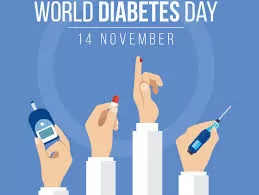- 80% of people with diabetes are diagnosed;
- 80% of people with diagnosed diabetes have good control of glycaemia;
- 80% of people with diagnosed diabetes have good control of blood pressure;
- 60% of people with diabetes of 40 years or older receive statins; and
- 100% of people with type 1 diabetes have access to affordable insulin and blood glucose self-monitoring.
World Diabetes Day provides an opportunity to raise awareness about diabetes as a critical global public health issue and emphasize the collective and individual actions needed to improve the prevention, diagnosis and management of the condition.
This year’s theme, “Breaking Barriers, Bridging Gaps,” underpins our commitment to reducing the risk of diabetes, and ensuring that all people who are diagnosed with diabetes have access to equitable, comprehensive, affordable and quality treatment and care.
Key facts
- The number of people living with diabetes rose from 200 million in 1990 to 830 million in 2022. Prevalence has been rising more rapidly in low- and middle-income countries than in high-income countries.
- More than half of people living with diabetes did not take medication for their diabetes in 2022. Diabetes treatment coverage was lowest in low- and middle-income countries.
- Diabetes causes blindness, kidney failure, heart attacks, stroke and lower limb amputation.
- In 2021, diabetes and kidney disease due to diabetes caused over 2 million deaths. In addition, around 11% of cardiovascular deaths were caused by high blood glucose.
- A healthy diet, regular physical activity, maintaining a normal body weight and avoiding tobacco use are ways to prevent or delay the onset of type 2 diabetes.
- Diabetes can be treated and its consequences avoided or delayed with diet, physical activity, medication and regular screening and treatment for complications.
Overview
Diabetes is a chronic disease that occurs either when the pancreas does not produce enough insulin or when the body cannot effectively use the insulin it produces. Insulin is a hormone that regulates blood glucose. Hyperglycaemia, also called raised blood glucose or raised blood sugar, is a common effect of uncontrolled diabetes and over time leads to serious damage to many of the body’s systems, especially the nerves and blood vessels.
In 2022, 14% of adults aged 18 years and older were living with diabetes, an increase from 7% in 1990. More than half (59%) of adults aged 30 years and over living with diabetes were not taking medication for their diabetes in 2022. Diabetes treatment coverage was lowest in low- and middle-income countries.
In 2021, diabetes was the direct cause of 1.6 million deaths and 47% of all deaths due to diabetes occurred before the age of 70 years. Another 530 000 kidney disease deaths were caused by diabetes, and high blood glucose causes around 11% of cardiovascular deaths (1).
Since 2000, mortality rates from diabetes have been increasing. By contrast, the probability of dying from any one of the four main noncommunicable diseases (cardiovascular diseases, cancer, chronic respiratory diseases or diabetes) between the ages of 30 and 70 decreased by 20% globally between 2000 and 2019.
Symptoms
Symptoms of diabetes may occur suddenly. In type 2 diabetes, the symptoms can be mild and may take many years to be noticed.
Symptoms of diabetes include:
- feeling very thirsty
- needing to urinate more often than usual
- blurred vision
- feeling tired
- losing weight unintentionally
Over time, diabetes can damage blood vessels in the heart, eyes, kidneys and nerves.
People with diabetes have a higher risk of health problems including heart attack, stroke and kidney failure.
Diabetes can cause permanent vision loss by damaging blood vessels in the eyes.
Many people with diabetes develop problems with their feet from nerve damage and poor blood flow. This can cause foot ulcers and may lead to amputation.
Type 1 diabetes
Type 1 diabetes (previously known as insulin-dependent, juvenile or childhood-onset) is characterized by deficient insulin production and requires daily administration of insulin. In 2017 there were 9 million people with type 1 diabetes; the majority of them live in high-income countries. Neither its cause nor the means to prevent it are known.
Type 2 diabetes
Type 2 diabetes affects how your body uses sugar (glucose) for energy. It stops the body from using insulin properly, which can lead to high levels of blood sugar if not treated.
Over time, type 2 diabetes can cause serious damage to the body, especially nerves and blood vessels.
Type 2 diabetes is often preventable. Factors that contribute to developing type 2 diabetes include being overweight, not getting enough exercise, and genetics.
Early diagnosis is important to prevent the worst effects of type 2 diabetes. The best way to detect diabetes early is to get regular check-ups and blood tests with a healthcare provider.
Symptoms of type 2 diabetes can be mild. They may take several years to be noticed. Symptoms may be similar to those of type 1 diabetes but are often less marked. As a result, the disease may be diagnosed several years after onset, after complications have already arisen.
More than 95% of people with diabetes have type 2 diabetes. Type 2 diabetes was formerly called non-insulin dependent, or adult onset. Until recently, this type of diabetes was seen only in adults but it is now also occurring increasingly frequently in children.
Gestational diabetes
Gestational diabetes is hyperglycaemia with blood glucose values above normal but below those diagnostic of diabetes. Gestational diabetes occurs during pregnancy.
Women with gestational diabetes are at an increased risk of complications during pregnancy and at delivery. These women and possibly their children are also at increased risk of type 2 diabetes in the future.
Gestational diabetes is diagnosed through prenatal screening, rather than through reported symptoms.
Impaired glucose tolerance and impaired fasting glycaemia
Impaired glucose tolerance (IGT) and impaired fasting glycaemia (IFG) are intermediate conditions in the transition between normality and diabetes. People with IGT or IFG are at high risk of progressing to type 2 diabetes, although this is not inevitable.
Prevention
Lifestyle changes are the best way to prevent or delay the onset of type 2 diabetes.
To help prevent type 2 diabetes and its complications, people should:
- reach and keep a health body weight
- stay physically active with at least 150 minutes of moderate exercise each week
- eat a healthy diet and avoid sugar and saturated fat
- not smoke tobacco.
Diagnosis and treatment
Early diagnosis can be accomplished through relatively inexpensive testing of blood glucose. People with type 1 diabetes need insulin injections for survival.
One of the most important ways to treat diabetes is to keep a healthy lifestyle.
Some people with type 2 diabetes will need to take medicines to help manage their blood sugar levels. These can include insulin injections or other medicines. Some examples include:
- metformin
- sulfonylureas
- sodium-glucose co-transporters type 2 (SGLT-2) inhibitors.
Along with medicines to lower blood sugar, people with diabetes often need medications to lower their blood pressure and statins to reduce the risk of complications.
Additional medical care may be needed to treat the effects of diabetes:
- foot care to treat ulcers
- screening and treatment for kidney disease
- eye exams to screen for retinopathy (which causes blindness).
Government of India’s Diabetes Prevention Initiatives
The Government of India has launched several proactive measures to tackle diabetes as part of the broader National Programme for Prevention and Control of Non-Communicable Diseases (NP-NCD) under the National Health Mission (NHM).
- The Government of India, under the NP-NCD, provides technical and financial assistance to states and UTs through the National Health Mission (NHM).
- Support is allocated based on state and UT proposals with a focus on prevention and management of diabetes and other non-communicable diseases.
- 743 District NCD Clinics and 6,237 Community Health Center NCD Clinics have been established across India to ensure local-level care and accessible services.
- Emphasis is on training healthcare personnel, strengthening healthcare infrastructure, and facilitating early diagnosis and referral.
- Implemented a population-based initiative that offers screening and control for common NCDs like diabetes, hypertension, and certain cancers. Targeting individuals over 30, screenings are a core part of the healthcare services provided at Ayushman Arogya Mandirs.
- These centers promote preventive health practices, conduct screenings, and engage in community-based wellness initiatives.
- Public awareness on diabetes is promoted through observance of national and international health days.
- A range of media, including print, electronic, and social platforms, is used to ensure consistent community awareness and education.
- Healthy lifestyle promotion includes guidance from the Food Safety and Standards Authority of India (FSSAI) on nutrition.
- The Fit India Movement, led by the Ministry of Youth Affairs and Sports, and yoga programs from the Ministry of AYUSH encourage active and healthy lifestyles.
- Under NP-NCD, states receive financial support for diabetes awareness programs as per their Program Implementation Plans.
- In addition to preventive measures, the NP-NCD also offers financial assistance for purchasing glucometers and diabetes medications, as requested by states and UTs. The NHM’s Free Drugs Service Initiative provides free essential medicines, including insulin, to economically vulnerable groups.
- Through the Pradhan Mantri Bhartiya Janaushadhi Pariyojana (PMBJP), quality generic medications, including insulin, are made available at affordable prices with state collaboration to ensure wider accessibility.












